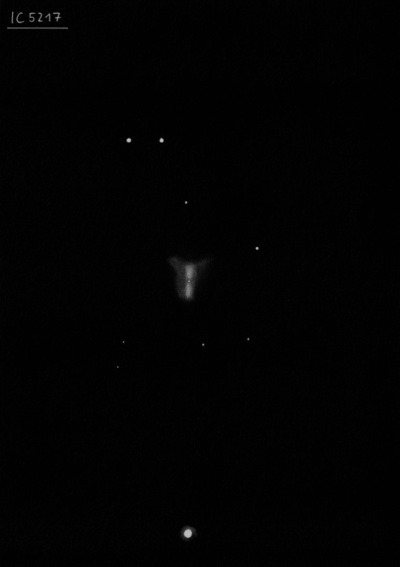
Williamina Fleming discovered IC 5217 = Fleming 102 in 1904 based on its emission line spectrum on a Harvard plate. Several visual observations were made by Thomas Espin in 1911 with his 17.25" reflector and he estimated the size from 2.5" to 4" in diameter and "apparently elongated N and S."
Based on Crossley photographs taken at Lick, Heber Curtis (1918) reported "no central star can be distinguished. A bright oval about 7.5"x6" in a 5 min exposure; slightly larger and quite "square-shouldered" in the long exposure. Brighter along the middle, but no details of structure can be made out."
200/250mm - 8" stellar planetary at 100x, slightly fuzzy at 220x and an easy ellipse is visible at 400x.
300/350mm - 13.1" (10/10/86): at 166x appears fairly bright but just non-stellar. Good contrast gain with OIII filter. A bright compact bluish disc is visible at 214x, slightly elongated. Estimate V = 11.5 and 5" diameter. Located 1.3° due south of mag 4.4 Beta Lac.
400/500mm - 18" (7/2/08): picked up easily at 174x as a "soft" mag 11.5 with a pale blue color. Good contrast gain blinking with an OIII filter. A brighter mag 10 comparison star lies 1.8' S but blinking with the filter the planetary switches apparent brightness with this star. At 435x, IC 5217 appeared as a 7"x5" blue disc, slightly elongated SSW-NNE. With direct vision, a slightly brighter quasi-stellar center was visible suggesting the central star was just below the threshold of visibility.
18" (12/08/07): picked up at 115x as a soft blue-grey "star". Good contrast gain using a NPB filter. Without a filter, a brighter mag 10 star lies to the south though with the filter the planetary matches the star. At 225x a definite small disc was visible, crisp-edged, round, ~6" diameter. The seeing was too soft to use high power.
Notes by Steve Gottlieb